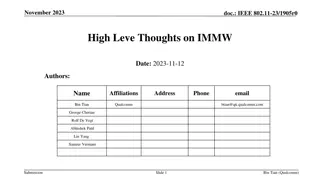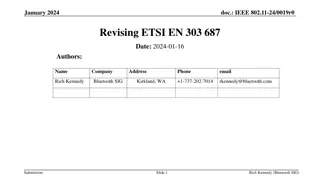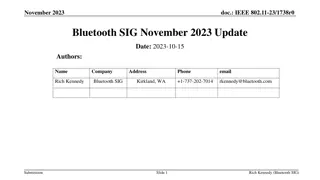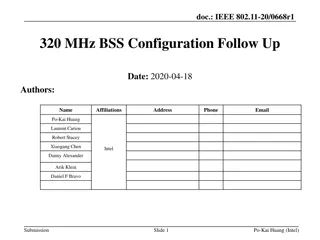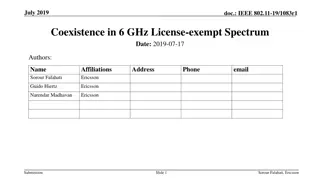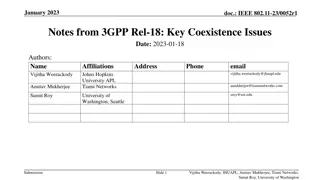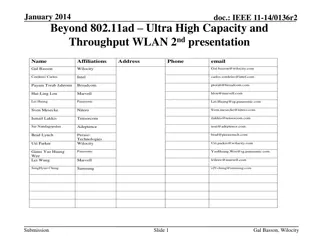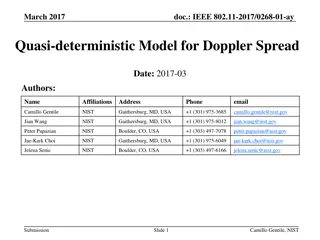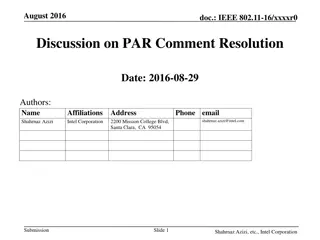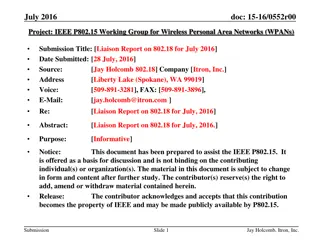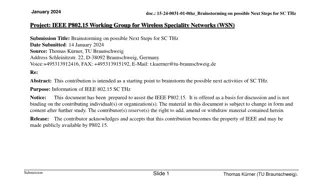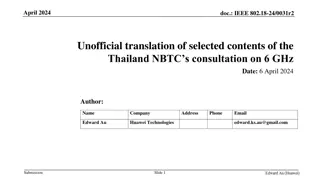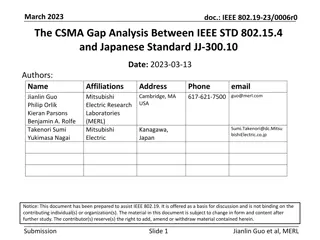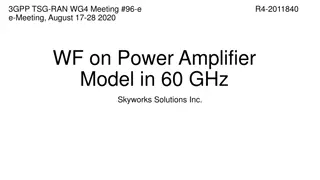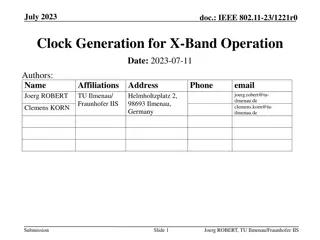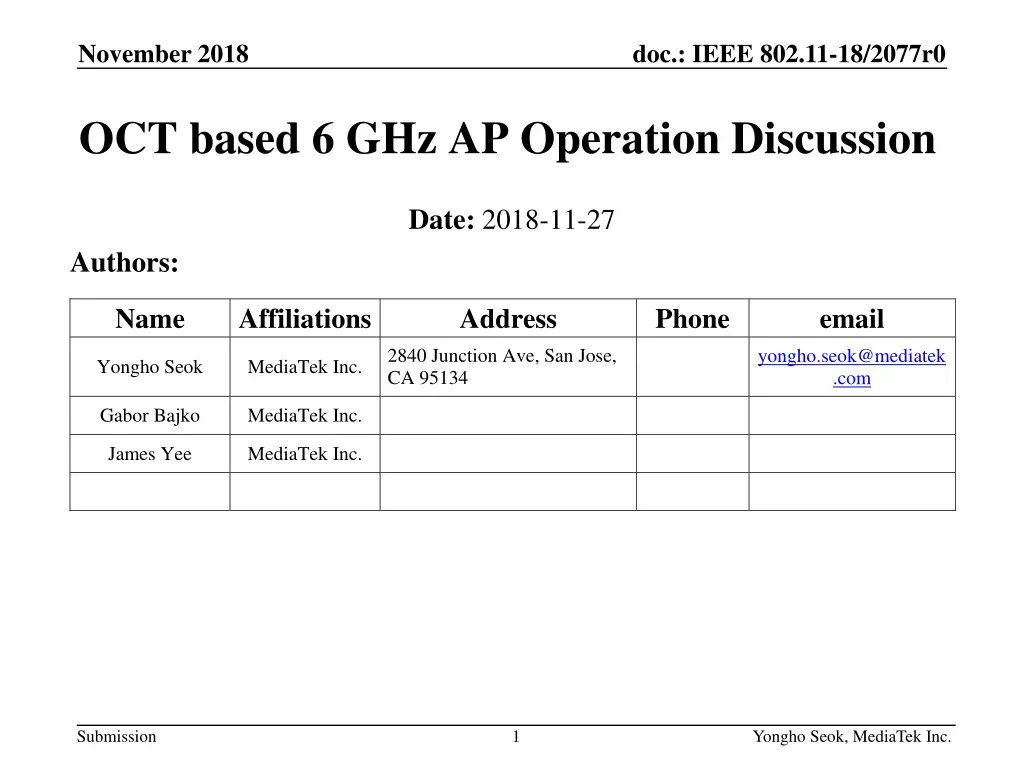
IEEE 802.11-18/2077r0 Recap on OCT Based 6 GHz AP Operation
Discussing the IEEE 802.11-18/2077r0 document focusing on the operational aspects of 6 GHz Access Points (APs). Covering topics such as supporting OCT, active scanning, authentication, and association in the 6 GHz band. Exploring the extension of on-channel tunneling for active scanning as discussed in the recent July 2018 meeting.
Download Presentation

Please find below an Image/Link to download the presentation.
The content on the website is provided AS IS for your information and personal use only. It may not be sold, licensed, or shared on other websites without obtaining consent from the author. If you encounter any issues during the download, it is possible that the publisher has removed the file from their server.
You are allowed to download the files provided on this website for personal or commercial use, subject to the condition that they are used lawfully. All files are the property of their respective owners.
The content on the website is provided AS IS for your information and personal use only. It may not be sold, licensed, or shared on other websites without obtaining consent from the author.
E N D
Presentation Transcript
November 2018 doc.: IEEE 802.11-18/2077r0 OCT based 6 GHz AP Operation Discussion Date: 2018-11-27 Authors: Name Affiliations Address Phone email 2840 Junction Ave, San Jose, CA 95134 yongho.seok@mediatek .com Yongho Seok MediaTek Inc. Gabor Bajko MediaTek Inc. James Yee MediaTek Inc. Submission 1 Yongho Seok, MediaTek Inc.
November 2018 doc.: IEEE 802.11-18/2077r0 Recap: CR for 6GHz [11-18/1127r9] The objective is that a STA that scans 2.4 and 5GHz will have all the information it requires to decide if it wants/can associated with one of the 6GHz APs. It should then get as much information as it would get by sending a probe request to the 6GHz AP. When it wants to associate with the 6GHz AP, it only needs to send one frame: association request. Submission 2 Yongho Seok, MediaTek Inc.
November 2018 doc.: IEEE 802.11-18/2077r0 Recap: CR for 6GHz [11-18/1127r9] A discovery mechanism for 2.4, 5 and 6 GHz allows: Detecting the BSSs that are collocated with the reporting device, i.e. operating in the same device that has transmitted the discovery information. Providing the information that the AP supports OCT, a mechanism already defined in the spec: Tunneling between the reporting device and the AP in 6 GHz to tunnel probe request/response, association and authentication frames that are transmitted over-the-air to the AP in lower band and tunnelled to the AP at 6GHz. Submission 3 Yongho Seok, MediaTek Inc.
November 2018 doc.: IEEE 802.11-18/2077r0 Recap: CR for 6GHz [11-18/1127r9] In the proposed changes, If the OCT Supported subfield is set to 1 in the Neighbor AP Information field describing an HE AP operation in the 6GHz band in the Reduced Neighbor Report element, then a non-AP STA that supports operation in the 6 GHz band may use the OCT procedure described in 11.31.5 (On-channel Tunneling (OCT) operation) to perform active scanning, authentication and/or association to the 6GHz AP through over-the-air transmissions with the AP that sent the Reduced Neighbor Report element and that is operating in the 2.4, 5 or 6GHz band. We want to further discuss some open issues about the OCT based 6 GHz AP operation. Submission 4 Yongho Seok, MediaTek Inc.
November 2018 doc.: IEEE 802.11-18/2077r0 OCT Progress The on-channel tunneling (OCT) is initially designed to perform the (de)authentication and (re)association through the out-of-band. In 4.9.4 (Reference model for multi-band operation), the on- channel tunneling (OCT) multi-band procedure enables the SMEs of a pair of multi-band capable devices to provide a seamless FST, including performing (de)authentication and (re)association across bands/channels. Submission 5 Yongho Seok, MediaTek Inc.
November 2018 doc.: IEEE 802.11-18/2077r0 OCT Progress But, in recent July 2018 meeting, 802.11md has extended the OCT to the active scanning purpose. The below is a summery of the recent OCT extension. Discussion 2: OCT is supported by several frame types, including for (re)association, ADDBA, ADDTS, etc. However, the same has not been done for probe frames. Therefore, propose to add the Multi-band element to the SCAN primitive. By doing so, it will also be possible to use OCT with probe frames. Please find the detail from 11-1178r1 document presented by Carlos (Intel). Also, the OCT mechanism is decoupled from the FST (Fast Session Transfer) mechanism. Previously, the multi-band capable device shall support the OCT and FST. Submission 6 Yongho Seok, MediaTek Inc.
November 2018 doc.: IEEE 802.11-18/2077r0 OCT based 6 GHz AP Operation : Pre-association Issue Our observation is that the OCT based 6 GHz AP discovery has several issues yet. 1) The On-channel Tunnel Request frame for carrying the Probe Request and Probe Response is not a public action frame. So, for discovering 6 GHz BSS through the OCT, a STA shall be associated with the AP. 5GHz AP Beacon [RNR] Association Response OCT Request [Probe Response] Probe Response contains 6GHz AP information. 5GHz STA Association Request OCT Request [Probe Request] Authentication Submission 7 Yongho Seok, MediaTek Inc.
November 2018 doc.: IEEE 802.11-18/2077r0 OCT based 6 GHz AP Operation : Pre-association Issue Our observation is that the OCT based 6 GHz AP discovery has several issues yet. 1) Just for obtaining more information (e.g., SSID, operation parameters) of 6 GHz AP, requiring association and authentication with 2.4/5 GHz AP is an unnecessary overhead. Submission 8 Yongho Seok, MediaTek Inc.
November 2018 doc.: IEEE 802.11-18/2077r0 OCT based 6 GHz AP Operation : Pre-association Issue Our observation is that the OCT based 6 GHz AP discovery has several issues yet. 2) The Probe Response frame has some band specific dynamic information. One example is the timestamp field. Since the timestamp is recorded by the hardware immediately before sending the Probe Response frame, it is hard for the hardware of 2.4/5 GHz AP to set the correct timestamp of the 6 GHz AP. Submission 9 Yongho Seok, MediaTek Inc.
November 2018 doc.: IEEE 802.11-18/2077r0 OCT based 6 GHz AP Operation : Pre-association Issue Our observation is that the OCT based 6 GHz AP discovery has several issues yet. 3) Criteria for sending a probe response (11.1.4.3.4) need clarification. E.g., a STA that receives a Probe Request frame shall not respond if any of the following apply: b) The Address 1 field of the Probe Request frame [Question: What is the Address 1 field of the Probe Request carried in OCT Request frame?] contains an individual address that is not the MAC address of the STA. Submission 10 Yongho Seok, MediaTek Inc.
November 2018 doc.: IEEE 802.11-18/2077r0 OCT based 6 GHz AP Operation : Post-association issue Our observation is that the normative behaviors of the AP and STA supporting the OCT has not been clearly defined. 4) After the OCT based 6 GHz AP association, the AP and STA concurrently maintains dual bands, 2.4/5 GHz and 6 GHz. In such situation, previously, the FST defined the normative behavior of the AP and STA for transferring the sessions. Now, the OCT mechanism independently works but the exact protocol behavior (e.g., session transmission) of the AP and STA is ambiguous. Beacon [RNR] Response 5GHz AP Association OCT Request [Association Resp] Association Request and Response makes a session with 6 GHz AP. 5GHz STA Association Request OCT Request [Association Req] Submission 11 Yongho Seok, MediaTek Inc.
November 2018 doc.: IEEE 802.11-18/2077r0 OCT based 6 GHz AP Operation For solving these issues, 1) Need to define a new public action frame for the On-channel Tunnel Request frame. 2) Change some band specific dynamic information in the Probe Response frame to a new semantics. 3) Revise the sub-clause 11.1.4.3.4 for clarification of the criteria for sending a probe response. 4) Need to define the normative behaviors of the AP and STA supporting the OCT. Submission 12 Yongho Seok, MediaTek Inc.
November 2018 doc.: IEEE 802.11-18/2077r0 Conclusion For making the OCT based 6 GHz AP operation to be valuable, we need to improve the protocol. Because current 11-18/1127r9 proposal is not a complete solution. Submission 13 Yongho Seok, MediaTek Inc.

